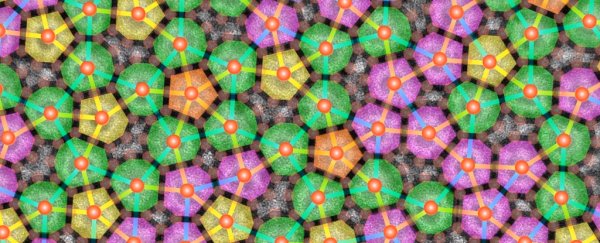Dan Shechtman has the rare honour of possessing a Nobel Prize for 'nonsense'.
It's been nearly four decades since he set out to convince the chemist community of a discovery most considered impossible – a material called a quasicrystal. Now we have just observed a brand new variety of these once 'impossible' materials for the first time, one based on a single unit.
Chemists from Brown University have described the successful creation of a self-constructing lattice structure based on a strangely shaped quantum dot.
"Single-component quasicrystal lattices have been predicted mathematically and in computer simulations, but hadn't been demonstrated before this," says chemist and senior author Ou Chen.
"It's a fundamentally new type of quasicrystal, and we've been able to figure out the rules for making it, which will be useful in the continued study of quasicrystal structures."
Shechtman was awarded his Nobel Prize for chemistry in 2011, recognising his work on showing how particles could form non-repeating patterns that didn't follow the usual rules.
Crystals are repetitive structures based on possible rotations – or symmetries – of its component units. Take one chunk of crystal and move it a certain distance, and it'll match up perfectly with another chunk.
Quasicrystals buck that trend. Like crystals, their components also lock together to fill up a space. Unlike crystals, their symmetries mean their arrangement won't repeat.
Mathematically it's easy enough to create such an arrangement, and has been demonstrated as possible for roughly half a century.
Confined to the kinds of building-blocks provided by nature, these aperiodic structures were long considered to be impossible.
Dan Schechtman wasn't convinced, observing strange diffraction patterns in rapidly quenched aluminium alloys. These were the first signs of impossible 'quasicrystals'.
It took a while for Shechtman to convince the community that he was onto something big. According to the famous chemist Linus Pauling, "Danny Shechtman is talking nonsense; there are no quasicrystals, just quasi-scientists."
Ouch.
Today, this family of crystal-but-not-a-crystal isn't just regarded as fact, but as a potentially highly useful type of material.
Most applications are as non-stick or anti-corrosion coatings for various instruments, but recent advances could see quasicrystals formed that manipulate light to create advanced forms of camouflage.
These are often complex metal alloys made from multiple types of unit. But this new discovery shows it's practically possible to build them from a single, oddly shaped puzzle piece.
Ironically, the research team hadn't set out to construct such a material. Their initial goal was to simply build macro-sized structures from nanoscale components.
A couple of years ago Chen developed a pyramid-shaped quantum dot – a nanometre sized tetrahedral particle – that could pack together more tightly than the usual spherical objects.
These unconventionally shaped dots also have one face with different bonding characteristics than the other faces, which changed how particles behaved in various orientations.
Not only did this produce an incredibly complex superstructure, it created a pattern that qualified as a quasicrystalline lattice.
"When I realized the pattern I was seeing was a quasicrystal, I emailed Ou and said 'I think I've found something super-great,'" says the study's lead author Yasutaka Nagaoka.
A scan using an electron microscope revealed the particles forming decagonal patterns that combined into a symmetry that isn't found in crystals.
The trick was in the particles' ability to form shapes other than decagons, which filled in the gaps to create non-repeating patterns.
"These decagons are in this confined space that they have to share peacefully," says Chen.
"So they do it by making their edges flexible when they need to."
The discovery adds new rules for constructing quasicrystals, not just for chemists hoping to make new generations of fancy materials, but for anybody seeking to create new patterns, from designers to mathematicians.
The world could use more 'nonsense' of this variety.
This research was published in Science.
